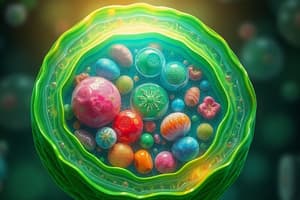Podcast
Questions and Answers
Match the following organelles with their primary function:
Match the following organelles with their primary function:
Nucleus = Controls cell activities and growth Ribosomes = Synthesize proteins Chloroplast = Conducts photosynthesis Cell Membrane = Regulates substance movement
Match the following characteristics to either plant or animal cells:
Match the following characteristics to either plant or animal cells:
Cell Wall = Only found in plant cells Shape = Rectangular for plant cells Chloroplasts = Present in plant cells Lysosomes = Present in animal cells
Match the following terms with their descriptions related to plant cells:
Match the following terms with their descriptions related to plant cells:
Cell Wall = Rigid outer layer providing structure Vacuoles = Large central structure in plant cells Cytoplasm = Fluid where organelles are suspended Chlorophyll = Pigment for photosynthesis in chloroplasts
Match the following differences between plant and animal cells:
Match the following differences between plant and animal cells:
Match the following statements with the correct cell type (Plant or Animal):
Match the following statements with the correct cell type (Plant or Animal):
Match the following organelles with their primary functions:
Match the following organelles with their primary functions:
Match the following cell types with their characteristics:
Match the following cell types with their characteristics:
Match the following definitions with their corresponding terms:
Match the following definitions with their corresponding terms:
Match the following functions with the correct organelles:
Match the following functions with the correct organelles:
Match the following terms with their descriptions:
Match the following terms with their descriptions:
Flashcards
Organelles
Organelles
Tiny structures within cells responsible for performing specific functions essential for cell growth, survival, and reproduction.
Endoplasmic reticulum (ER)
Endoplasmic reticulum (ER)
A network of folded membranes that produce proteins and lipids.
Golgi apparatus
Golgi apparatus
Stacks of flattened sacs that process and package proteins made by the ER for delivery within the cell or outside.
Mitochondria
Mitochondria
Signup and view all the flashcards
Vacuole (Plant)
Vacuole (Plant)
Signup and view all the flashcards
Cytoplasm
Cytoplasm
Signup and view all the flashcards
Nucleus
Nucleus
Signup and view all the flashcards
Ribosomes
Ribosomes
Signup and view all the flashcards
Cell membrane
Cell membrane
Signup and view all the flashcards
Lysosomes
Lysosomes
Signup and view all the flashcards
Study Notes
Organelles: The Building Blocks of Cells
- Organelles are tiny structures within cells that perform specific functions essential for cell growth, survival, and reproduction.
- Organelles work together to maintain the cell's overall function.
Plant Cell: Features and Function
- Endoplasmic reticulum (ER): A network of folded membranes that produce proteins and lipids.
- Golgi apparatus: Stacks of flattened sacs that process and package proteins made by the ER for delivery within the cell or outside.
- Mitochondria: Powerhouses of the cell, converting food energy into usable energy (ATP) through cellular respiration.
- Vacuole: A large, fluid-filled sac that stores water, nutrients, and waste products. Provides structural support and helps regulate cell volume.
- Cytoplasm: A gel-like substance that fills the cell and surrounds organelles. Facilitates movement of substances within the cell.
- Nucleus: The control center of the cell, containing DNA that directs cell activities.
- Ribosomes: Tiny organelles responsible for protein synthesis.
- Cell membrane: A thin, flexible barrier that encloses the cytoplasm and controls the passage of substances into and out of the cell.
- Cell wall: A rigid outer layer that provides support and structure, allowing the cell to maintain its shape.
- Chloroplasts: Site of photosynthesis, containing chlorophyll which captures light energy to produce sugars (food) for the plant.
Animal Cell: Distinctive Features
- Lysosomes: Digestive compartments within cells that break down waste materials, cellular debris, and engulfed bacteria.
- Vacuoles: Smaller than plant vacuoles, they are involved in storage and transport within the cell.
Key Differences Between Plant and Animal Cells
- Cell wall: Only plant cells have a rigid cell wall for structural support.
- Chloroplasts: Only plant cells have chloroplasts for photosynthesis.
- Shape: Plant cells are often rectangular, while animal cells exhibit more diverse shapes.
- Vacuoles: Plant cells typically have one large central vacuole, while animal cells have multiple smaller vacuoles.
- Lysosomes: Animal cells possess lysosomes for intracellular digestion, whereas plant cells have other mechanisms for breakdown.
Studying That Suits You
Use AI to generate personalized quizzes and flashcards to suit your learning preferences.




